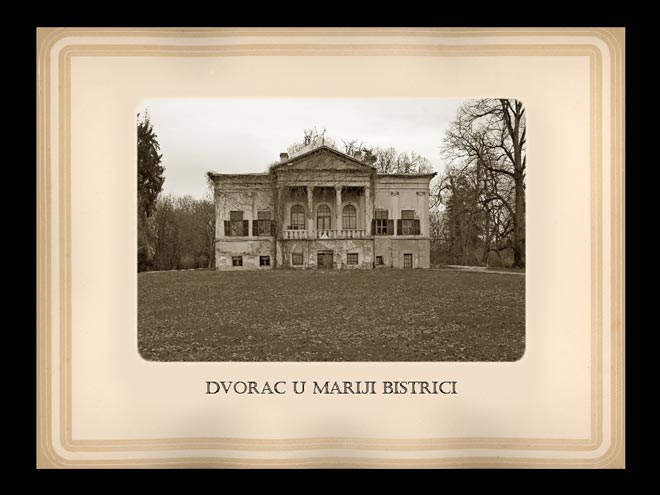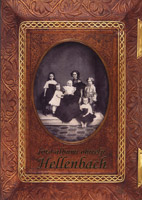Photographic Albums of the Hellenbach Family
Exhibition concept: Slavko Šterk
Multimedia: Maja Šojat-Bikić, MSc
Exhibition design: Željko Kovačić
Poster design: Miljenko Gregl
 The idea to put on this exhibition was born in May 2003 during the visit of members of the Kajkavsko Spravišće Association to Castle Hellenbach in Marija Bistrica, on which occasion eighteen family photograph albums were found in the library of the building. In the following year a number individual, framed and glazed photos on the walls of the castle as well as a certain number of photographs found in boxes were recorded. In 2005 all the photographic albums were copied, and in 2006 they were inventoried. During 2007 and 2008 the most at risk were restored. After archival research, copies of the photographs were made, following the chronological order of the topics. This is the content of Topic 1, entitled Dawn.
The idea to put on this exhibition was born in May 2003 during the visit of members of the Kajkavsko Spravišće Association to Castle Hellenbach in Marija Bistrica, on which occasion eighteen family photograph albums were found in the library of the building. In the following year a number individual, framed and glazed photos on the walls of the castle as well as a certain number of photographs found in boxes were recorded. In 2005 all the photographic albums were copied, and in 2006 they were inventoried. During 2007 and 2008 the most at risk were restored. After archival research, copies of the photographs were made, following the chronological order of the topics. This is the content of Topic 1, entitled Dawn.
Topic 2, entitled Family contains an incomplete genealogical tree of the Hellenbach family, showing the male ancestral line with references to the years of the births and deaths of some of the members of the family right up to the present time. The tree is presented in a compact, graphic form, with a coat of arms, which was gradually expanded by weddings and marriages, as well as descriptively with a series of details from the lives of the ancestors.
In Topic 3, Roots, we are concerned with three proud women and two determined men who with their gestures, action, intentions and conduct indicate the roots of the Hellenbach family. They are Marija or Mariska, née Countess Dessewffy, wife of Dionis von Hellenbach, who, when she was thirty years old, without any preconceptions, dressed up in a miner’s uniform in order to refer to the oldest ancestor of the family, Jeremija, who lived in the mining city of Kremnica in Slovakia. Then there is Helena Karapanđa (Black), daughter from the second marriage of Zdenka von Hellenbach and general Nikola Karapanđa, who not only attempted to find the remnants of Sveta Helena, the first castle of the family, but had the ambition to rescue the statue of St Helen from the chapel of the same name. Also featured is Lazar von Hellenbach, politician, philosophical writer and journalist who is right at the centre of the family. When he married Klotilda Jelačić of Bužim, had with her numerous children, who then contracted their own marriages, the family additionally expanded, having relations by marriage with the families of Jelačić-Sermage, Papadopoli-Aldobrandini, Kulmer, Dessewffy and Vraniczany-Dobrinović. His wife brought him as a dowry not only the castle in Marija Bistrica but also the palace in Sjemenišna ulica 3 in Zagreb. At the end, we have one of the last male members of the family, Zdenko Hellenbach, captain in the Austro-Hungarian Navy and that of pre-war Yugoslavia, who managed to make sure that the castle and the grounds were placed on the heritage list, and so is most responsible for their preservation in the wartime and post-war years.
In Topic 4, Life in the Countryside, we reveal a new name in amateur photography in Croatia, the unmarried noblewoman Elizabeta, Countess of Trakošćan. In her photographic album signed Hell. Fa. III we can find photos that she took between 1896 and 1916, above all on the estate of her parents in Castle Bisag, in the castles of the Erdödys in Hungary, in the Pejačević palaces in Našice, and in Zagreb. As well as Elizabeta Drašković we follow in parallel the life of a second unmarried noblewoman Gisella von Hellenbach. On the marriage of her elder sister Helena von Hellenbach to Count Nikola Papadopoli-Aldobrandi, she and her younger sister were given the chance to travel to northern Italy. Helena’s husband, Count Nikola, was a senator of the Kingdom of Italy, a scion of an ancient Italian family that had several celebrated Papadopoli Palazzos in Venice, a number of gorgeous palaces in Rome, and estates and villas in upper Italy, in San Polo di Piave. Gisella compiled her photographic album, called Hell. Fa. XVII, carefully pasting into it photographs by, alas, unknown photographers.
Finally, in Topic 5, entitled Preserved Image we enter the world of all the eighteen photographic albums of the Hellenbach family, in which we notice the absolute dominance of portraits, on visiting card size and cabinet format, at a time when the photographic studio had become a new and fashionable place at which to meet people. The photographic albums are distinctive for their exterior, interior, originality and function. It can be seen that in every photo album of the Hellenbach family a group memory is constituted. We can find in them very heterogeneous relations, photographs of persons who are very close as well as those of people who are extremely distant, not only in familial but also in social terms. The most numerous photographic albums of the Hellenbach family are the so-called family albums and the portrait albums. This last topic is accompanied by an electronic catalogue with 302 photographs, by Maja Šojat-Bikić, which can be searched by albums.
Slavko Šterk
Pictures from the exhibition
.jpg)

photo Miljenko Gregl and Maja Šojat-Bikić, ZCM
 Exhibition catalogue
Exhibition catalogue
Šterk, Slavko. Photograph albums of Hellenbach family from Marija Bistrica.
Zagreb : Zagreb City Museum, 2009

